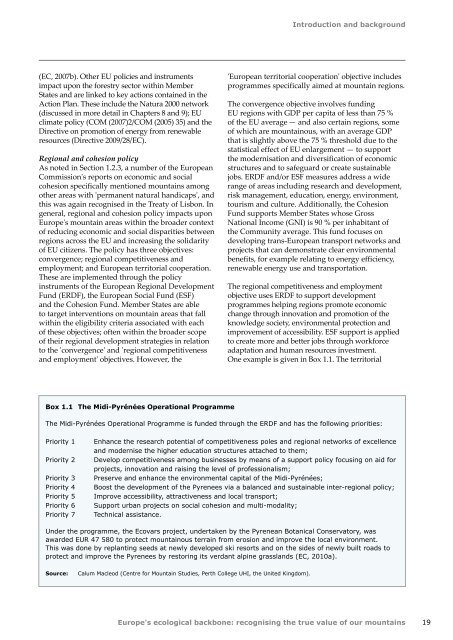Europes ecological backbone.pdf
Europes ecological backbone.pdf
Europes ecological backbone.pdf
Create successful ePaper yourself
Turn your PDF publications into a flip-book with our unique Google optimized e-Paper software.
Introduction and background<br />
(EC, 2007b). Other EU policies and instruments<br />
impact upon the forestry sector within Member<br />
States and are linked to key actions contained in the<br />
Action Plan. These include the Natura 2000 network<br />
(discussed in more detail in Chapters 8 and 9); EU<br />
climate policy (COM (2007)2/COM (2005) 35) and the<br />
Directive on promotion of energy from renewable<br />
resources (Directive 2009/28/EC).<br />
Regional and cohesion policy<br />
As noted in Section 1.2.3, a number of the European<br />
Commission's reports on economic and social<br />
cohesion specifically mentioned mountains among<br />
other areas with 'permanent natural handicaps', and<br />
this was again recognised in the Treaty of Lisbon. In<br />
general, regional and cohesion policy impacts upon<br />
Europe's mountain areas within the broader context<br />
of reducing economic and social disparities between<br />
regions across the EU and increasing the solidarity<br />
of EU citizens. The policy has three objectives:<br />
convergence; regional competitiveness and<br />
employment; and European territorial cooperation.<br />
These are implemented through the policy<br />
instruments of the European Regional Development<br />
Fund (ERDF), the European Social Fund (ESF)<br />
and the Cohesion Fund. Member States are able<br />
to target interventions on mountain areas that fall<br />
within the eligibility criteria associated with each<br />
of these objectives; often within the broader scope<br />
of their regional development strategies in relation<br />
to the 'convergence' and 'regional competitiveness<br />
and employment' objectives. However, the<br />
'European territorial cooperation' objective includes<br />
programmes specifically aimed at mountain regions.<br />
The convergence objective involves funding<br />
EU regions with GDP per capita of less than 75 %<br />
of the EU average — and also certain regions, some<br />
of which are mountainous, with an average GDP<br />
that is slightly above the 75 % threshold due to the<br />
statistical effect of EU enlargement — to support<br />
the modernisation and diversification of economic<br />
structures and to safeguard or create sustainable<br />
jobs. ERDF and/or ESF measures address a wide<br />
range of areas including research and development,<br />
risk management, education, energy, environment,<br />
tourism and culture. Additionally, the Cohesion<br />
Fund supports Member States whose Gross<br />
National Income (GNI) is 90 % per inhabitant of<br />
the Community average. This fund focuses on<br />
developing trans-European transport networks and<br />
projects that can demonstrate clear environmental<br />
benefits, for example relating to energy efficiency,<br />
renewable energy use and transportation.<br />
The regional competitiveness and employment<br />
objective uses ERDF to support development<br />
programmes helping regions promote economic<br />
change through innovation and promotion of the<br />
knowledge society, environmental protection and<br />
improvement of accessibility. ESF support is applied<br />
to create more and better jobs through workforce<br />
adaptation and human resources investment.<br />
One example is given in Box 1.1. The territorial<br />
Box 1.1 The Midi-Pyrénées Operational Programme<br />
The Midi-Pyrénées Operational Programme is funded through the ERDF and has the following priorities:<br />
Priority 1<br />
Priority 2<br />
Priority 3<br />
Priority 4<br />
Priority 5<br />
Priority 6<br />
Priority 7<br />
Enhance the research potential of competitiveness poles and regional networks of excellence<br />
and modernise the higher education structures attached to them;<br />
Develop competitiveness among businesses by means of a support policy focusing on aid for<br />
projects, innovation and raising the level of professionalism;<br />
Preserve and enhance the environmental capital of the Midi-Pyrénées;<br />
Boost the development of the Pyrenees via a balanced and sustainable inter-regional policy;<br />
Improve accessibility, attractiveness and local transport;<br />
Support urban projects on social cohesion and multi-modality;<br />
Technical assistance.<br />
Under the programme, the Ecovars project, undertaken by the Pyrenean Botanical Conservatory, was<br />
awarded EUR 47 580 to protect mountainous terrain from erosion and improve the local environment.<br />
This was done by replanting seeds at newly developed ski resorts and on the sides of newly built roads to<br />
protect and improve the Pyrenees by restoring its verdant alpine grasslands (EC, 2010a).<br />
Source:<br />
Calum Macleod (Centre for Mountain Studies, Perth College UHI, the United Kingdom).<br />
Europe's <strong>ecological</strong> <strong>backbone</strong>: recognising the true value of our mountains<br />
19

















